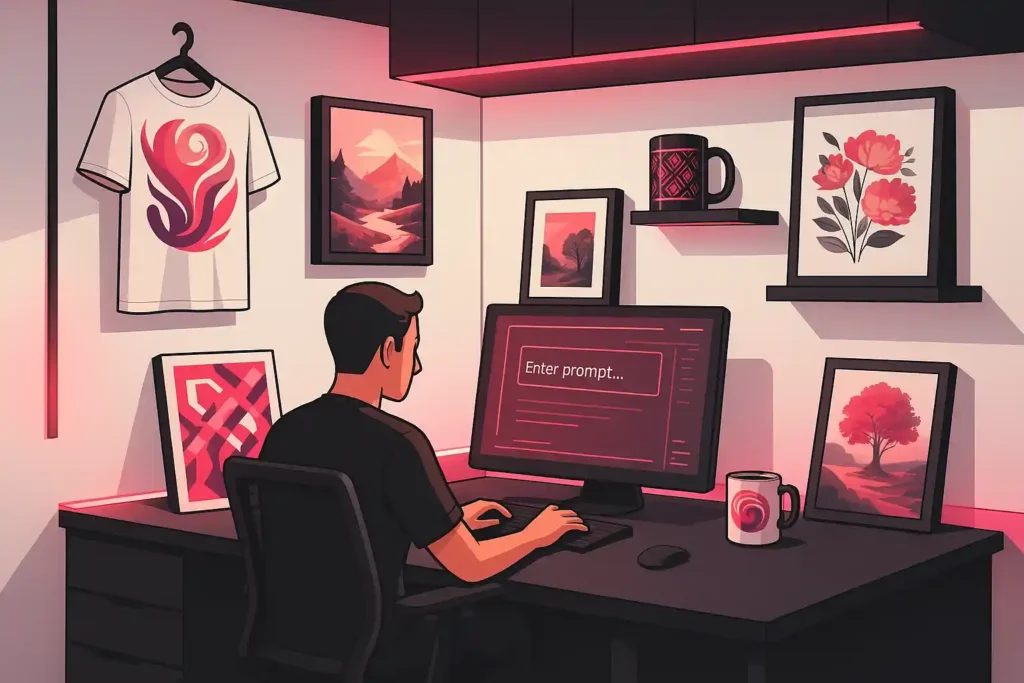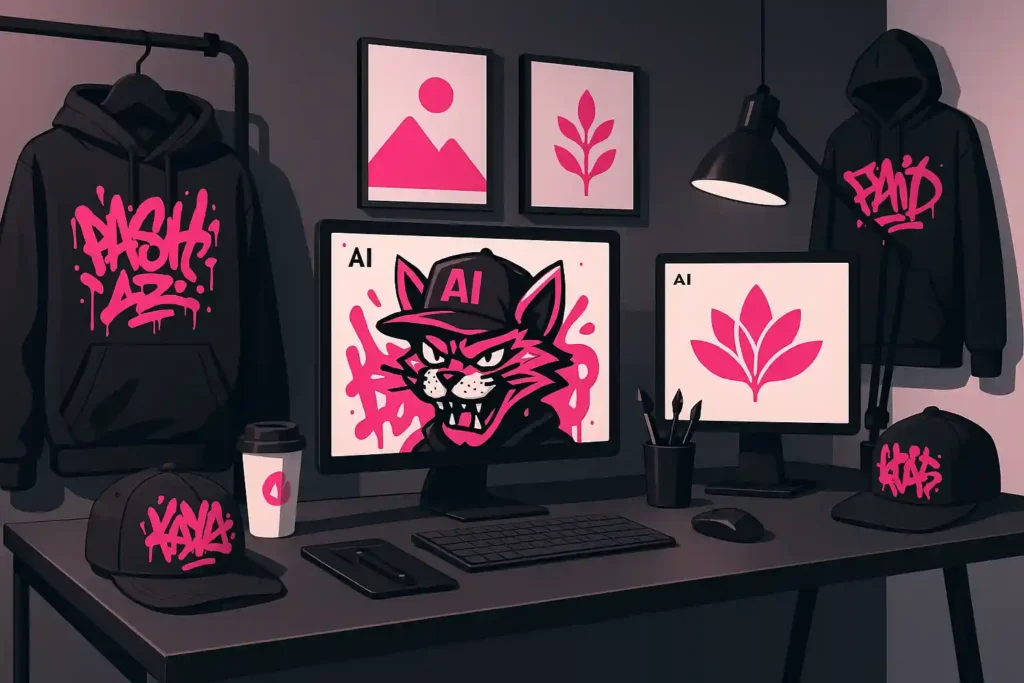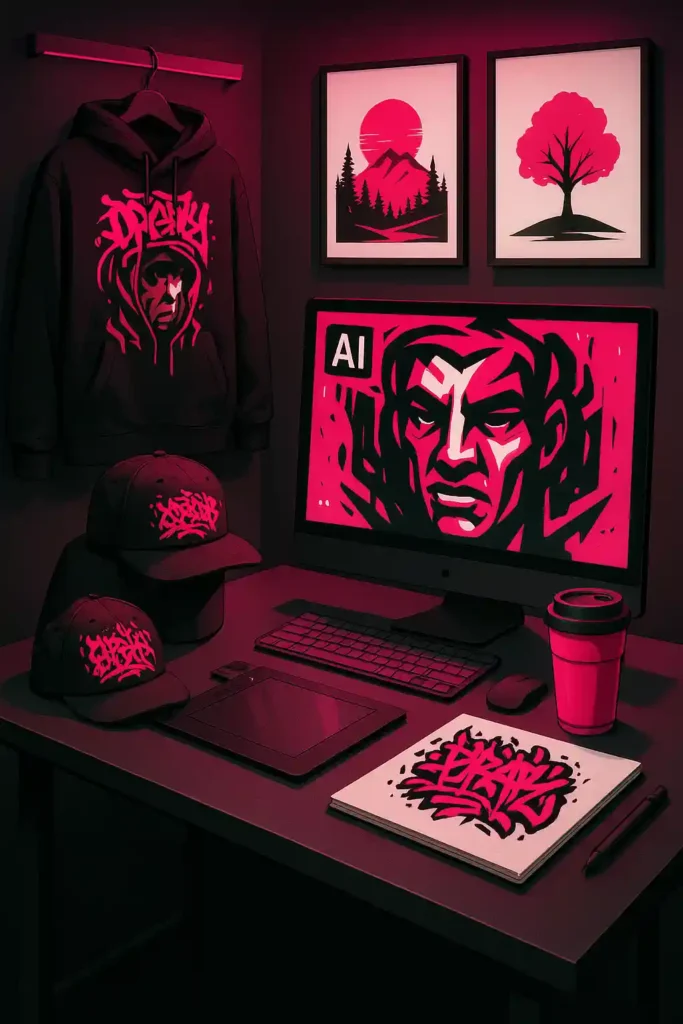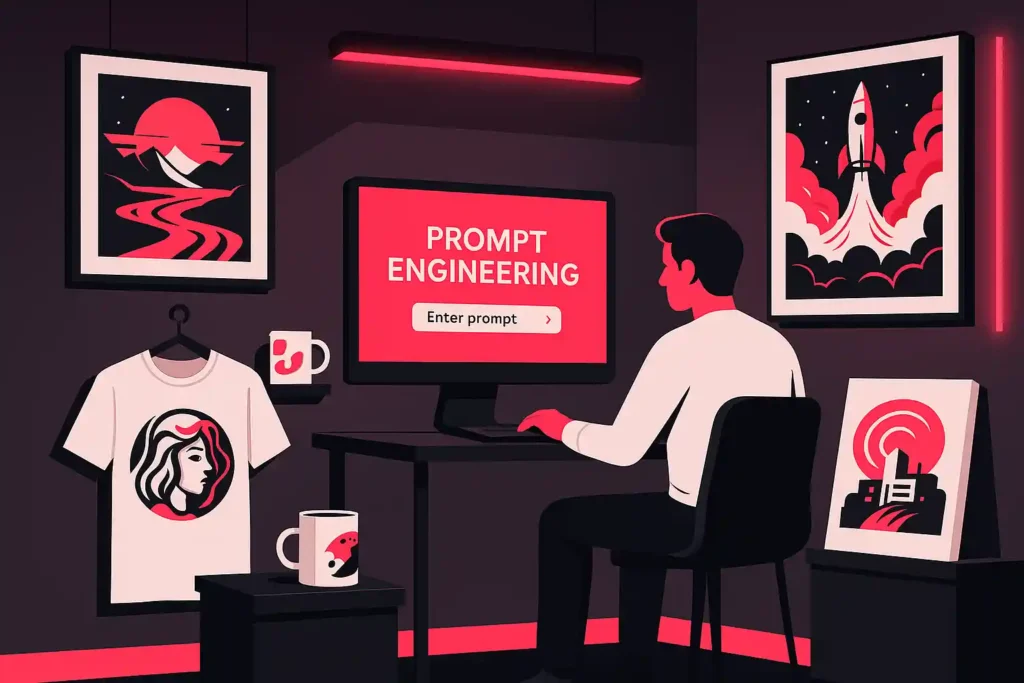Artificial intelligence is revolutionizing the Print-on-Demand (POD) industry by empowering creators to generate stunning artwork using simple text prompts. With the rise of AI-powered design tools like Midjourney, DALL·E, and Deep Dream, prompt engineering has become a critical skill for anyone looking to create unique, market-ready designs. In this guide, we’ll explore the fundamentals of prompt engineering, reveal techniques to unleash creativity, and show how you can leverage AI art for a thriving POD business.
The Role of AI in the POD Landscape
The POD industry has always thrived on creativity and innovation. In today’s highly competitive market, standing out means offering designs that are not only unique but also professionally executed. Traditional design methods can be time-consuming and may require advanced skills, but AI-powered tools are changing the game by generating artwork in seconds. These platforms allow sellers to quickly produce visuals for custom apparel, accessories, home decor, and more, drastically reducing the time from concept to product.
AI art generators can transform simple text prompts into detailed illustrations, patterns, and artistic compositions. The quality and style of the output largely depend on how well you craft your prompts—a process known as prompt engineering. By mastering this skill, creators can control the aesthetics, mood, and details of their designs, ensuring that the final product aligns perfectly with their brand vision.
Understanding Prompt Engineering
Prompt engineering is the process of designing and refining text inputs to guide AI models in generating desired outputs. The more detailed and specific your prompt, the better the AI can interpret your vision. A well-crafted prompt can help you tap into the full potential of AI, resulting in artwork that is not only visually stunning but also tailored to specific themes and audiences.
The Anatomy of an Effective Prompt
An effective prompt should include the following elements:
Clear Descriptions: Describe what you want in precise terms. Instead of a vague instruction like “create a landscape,” specify details such as “a vibrant sunset over a mountainous landscape with a river flowing through a lush valley.”
Artistic Style: Mention the style or medium you prefer, such as watercolor, oil painting, minimalist digital art, or abstract expressionism.
Mood and Atmosphere: Describe the emotional tone of the design. Words like “serene,” “energetic,” or “mysterious” can help the AI capture the intended ambiance.
Specific Elements: Include any key elements that must appear in the design. For instance, if creating a design for a POD product, you might mention elements like “intricate geometric patterns” or “hand-drawn floral motifs.”
Modifiers and Adjectives: Use modifiers to enhance the detail of the prompt. Terms like “high resolution,” “vibrant colors,” and “detailed textures” guide the AI in producing a high-quality output.
By experimenting with these components, you can gradually fine-tune your prompts to produce more refined and creative artwork.

Techniques to Unleash Creativity with AI Art
Experimentation and Iteration
The first step in mastering prompt engineering is experimentation. Start with a simple prompt and gradually add details. Experiment with different adjectives, artistic styles, and composition instructions to see how slight changes affect the final output. Don’t be afraid to iterate—often, the first few outputs are just stepping stones toward achieving the perfect design.
For example, begin with a prompt like, “a futuristic cityscape.” Then, add more details: “a futuristic cityscape at dusk, illuminated by neon lights, with flying cars and towering skyscrapers in a cyberpunk style.” Compare the outputs and note which elements resonate with your brand’s vision.
Use Comparative Prompts
Comparative prompts can help you understand how variations in wording lead to different artistic results. Create two or more similar prompts with slight modifications and compare the results side-by-side. This technique can reveal subtle nuances in how the AI interprets specific words and phrases, allowing you to adjust your language for the desired outcome.
Leverage AI Feedback
Some advanced AI art platforms provide feedback on prompt effectiveness. Use these insights to refine your language further. Look at the generated images and consider what works well and what could be improved. Adjust your prompt accordingly and re-run the process until you achieve the best possible design.
Combining Prompts with Manual Edits
While AI can generate impressive artwork, the best results often come from a combination of AI output and manual refinement. Use the AI-generated design as a foundation, then employ graphic design software to tweak elements, enhance colors, or add personal touches. This blend of automation and manual creativity results in truly unique designs that reflect both the power of AI and the human artistic touch.
AI Art in the POD Workflow
Integrating AI art into your POD workflow can streamline your entire production process. Here’s how:
Rapid Prototyping
With AI-generated designs, you can quickly produce multiple variations and mockups. This rapid prototyping helps you decide which designs are most appealing before investing in physical products. It also enables you to test different styles and trends without the risk of large upfront costs.
Automated Mockups and Product Previews
High-quality mockups are essential for showcasing your products online. AI-powered mockup generators create realistic product previews by applying your designs to various templates—such as t-shirts, mugs, and posters. These mockups can be used in your online store and marketing campaigns to boost customer confidence and drive sales.
Enhanced Customization
AI enables a high level of customization. You can offer personalized products where customers tweak AI-generated designs by choosing color schemes, adding text, or adjusting layout elements. This interactive customization builds stronger customer engagement and loyalty.
Marketing and SEO Advantages
AI-generated designs aren’t just for products—they also enhance your marketing materials. Use AI to create eye-catching social media posts, banner ads, and product descriptions that are optimized for search engines. By automating content creation, you ensure consistency across your branding and save time on marketing efforts.
Real-World Success: Case Studies and Examples
Many successful POD businesses have already embraced AI art to fuel their creative process. For instance, brands leveraging AI tools have reported significant improvements in design speed and overall quality. Some have even tapped into niche markets by using AI to generate designs that perfectly match current trends.
Consider a POD seller specializing in trendy streetwear. By using an AI art generator with detailed prompt engineering, they created a series of urban, graffiti-inspired designs. These designs resonated with a younger audience and went viral on social media, leading to a dramatic increase in sales. Another example is a home decor brand that used AI to generate minimalist, nature-inspired artwork, which they applied to high-quality prints and wall art. The result was a cohesive product line that appealed to modern, design-savvy consumers.
These success stories illustrate that with the right approach to prompt engineering and AI integration, any POD business can unlock new levels of creativity and market success.

How to Get Started with Prompt Engineering for AI Art
1. Choose the Right AI Tool
Select an AI platform that suits your design needs. Tools like Midjourney, DALL·E, and Deep Dream are popular for generating artwork, while platforms like Canva or Adobe Spark can help you refine and edit your creations. For a comprehensive solution tailored to POD, consider using Effortlesspod, which offers advanced features such as prompt-to-image conversion, image-to-image transformation, upscaling, background removal, and automatic caption and tag generation.
2. Learn the Basics of Prompt Engineering
Invest time in understanding how different prompts affect the output. Start with simple descriptions and gradually incorporate more details. Use online resources, tutorials, and community forums to learn from other creators who are mastering prompt engineering.
3. Experiment and Iterate
Don’t be afraid to experiment. The more you practice, the better you’ll become at crafting effective prompts. Use comparative and iterative approaches to refine your input until you consistently get high-quality outputs that match your vision.
4. Integrate AI into Your Workflow
Once you have a good grasp of prompt engineering, integrate AI-generated designs into your POD workflow. Use automated mockup generators, editing software, and eCommerce platforms like Printify to turn your digital creations into physical products. Embrace AI-powered marketing to promote your products and reach a wider audience.
The Future of AI in POD
The capabilities of AI in design are continually evolving. As AI technology advances, we can expect even more sophisticated tools that offer greater control over the creative process. Future innovations may include real-time design adjustments based on customer feedback, even more refined art generation techniques, and seamless integration of AI into every aspect of the POD workflow.
For POD sellers, staying ahead means continuously learning and adapting to new AI advancements. Embracing these technologies now will not only improve your current operations but also position your business for long-term success in an increasingly digital marketplace.

Conclusion
Prompt engineering for AI art is unlocking a new era of creativity in the Print-on-Demand industry. By mastering the art of crafting detailed, effective prompts, you can harness the power of AI to generate unique, market-ready designs in a fraction of the time it takes using traditional methods. AI tools offer speed, efficiency, and endless creative possibilities, while also streamlining your workflow from design to marketing and product fulfillment.
Whether you’re a beginner just starting out or a seasoned POD seller looking to innovate, integrating AI into your creative process can lead to remarkable improvements in quality, efficiency, and sales. Embrace the future of design, experiment with new techniques, and let AI help transform your creative vision into profitable products.
Start your journey today by exploring AI-powered tools and refining your prompt engineering skills. The future of POD is here—and it’s more creative, efficient, and exciting than ever.
FAQs
What is AI-generated art and how is it used in Print-on-Demand?
AI-generated art is artwork created using tools like Midjourney, DALL·E, or our own integrated design platform. You simply enter a descriptive prompt, and the AI generates a visual design based on your input. These unique designs can be printed on apparel, mugs, wall art, stationery, and more—ready for sale in your online store.
Do I need design experience to use AI for POD?
Platforms like Printful, Printify, and Gooten offer POD services. Researching suppliers, checking product quality, and comparing pricing are essential steps.
What are the best AI tools for POD designers?
Effective strategies include social media marketing, influencer collaborations, niche targeting, SEO, and email campaigns. Running paid ads on platforms like Facebook and Instagram can also help drive traffic and sales.
How can I ensure my AI designs are unique and not copied?
Popular AI tools for creating designs include:
Midjourney (great for detailed, artistic renders)
DALL·E 3 (from OpenAI, perfect for clean and creative concepts)
Dream by WOMBO
DeepArt (turns your photos into stylized art)
These platforms let you create artwork with just text and a bit of experimentation.
Can I legally sell AI-generated designs on POD platforms?
Yes, in most cases—but it depends on the tool’s licensing terms. Platforms like Midjourney allow commercial use with a paid plan. Always read the commercial licensing terms of the AI tool you’re using. And ensure your prompts do not replicate copyrighted characters or brand-related content.
What makes a good AI art prompt for POD?
A good prompt is specific, imaginative, and style-oriented. For example:
Instead of saying “cat”, try “A cosmic cat floating in space with neon galaxy colors, vaporwave style, 4k resolution”.
The more details you give (style, colors, mood, composition), the better and more sellable the results.
How do I choose the right AI-generated designs for my store?
Think about your niche and your audience. Are they into vintage aesthetics, funny quotes, fantasy creatures, or minimalist graphics? Test different AI styles and ask your audience for feedback. You can also check your competitors’ bestsellers for design inspiration.
Are AI-generated designs accepted on POD platforms like Printify, Redbubble, or Etsy?
Yes, AI art is widely accepted on these platforms, as long as you have the rights to the designs. Just ensure your designs meet their quality standards and do not violate community guidelines (e.g., no offensive or misleading content).Lorem ipsum dolor sit amet, consectetur adipiscing elit. Ut elit tellus, luctus nec ullamcorper mattis, pulvinar dapibus leo.
How can I make my AI designs stand out in a crowded market?
Combine AI-generated elements with text or personal graphics.
Create collections or series that tell a story.
Focus on trending themes, holidays, or niches.
Use branding consistently across your designs and store.
Offer mockups that showcase your designs in real-world scenarios.
Will AI replace human creativity in POD?
AI is a tool, not a replacement. It helps speed up the design process and sparks new ideas, but the creativity, storytelling, and brand-building still depend on you. The best results happen when humans and AI collaborate—so you stay in control of the final product and business direction.

